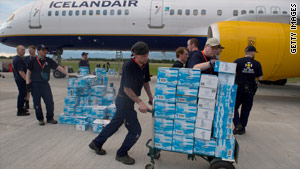Chaos at Haiti airport calmed by Air Force

- Earthquake leads to an uncontrolled "mess," says Air Force commander
- Lack of refueling ability, trucks to tow planes, causing problems
- Airport access is desperately needed because the main port is severely damaged
Washington (CNN) -- Haiti's Port-au-Prince airport, now critical for the quick delivery of supplies and aid, was an uncontrolled "mess" when the Air Force arrived Wednesday night to rehabilitate the facility, according to the commander of one of the Air Force's elite special operations units send to Haiti.
One of the biggest problems early on was that for more than a day after the earthquake, the airport was in disarray, Lt. Col. Brett Nelson said. Planes landed and parked just about anywhere.
"When we initially established airfield control last night, that followed 24 hours of uncontrolled activity," Nelson said.
The situation forced delays for arriving aircraft Thursday. At one point, Nelson said, there were 44 planes parked at the airport, but only two fuel trucks to refuel the planes and two tow carts for moving the planes.
One very large plane was on the tarmac in need of more fuel and it took more than six hours to get that plane out of the way.
The airport, used to handling about 25 flights daily, had 74 flights on Wednesday and 55 flights by midafternoon on Thursday, CNN's Chris Lawrence reported from the airport.
 Video: U.S. doctors help in Haiti
Video: U.S. doctors help in Haiti
 Video: Navy 'Planning for the worst'
Video: Navy 'Planning for the worst'
The Federal Aviation Administration imposed a "ground stop" for most of Thursday for aid aircraft heading to Haiti, because the crowding preventing new planes from arriving until existing planes departed.
The agency later canceled the stop, opening the gates for U.S. planes bound for Haiti with relief workers and supplies. But the FAA cautioned that some planes were kept flying in holding patterns off Haiti "in excess of three hours," before they were cleared to land. The FAA said holding delays could continue for the next several days.
"Excessive holding and diversions [to other airports] are a strong possibility," the FAA said.
Because of the difficulty in refueling planes, Nelson said the Air Force is trying to make sure that any planes flying into Port-au-Prince have adequate fuel to fly out.
The Air Force's 23rd Special Tactics Squadron is part of the Air Force equivalent of the Navy SEALS or the Army's Delta Force.
Nelson said the squadron flew into Haiti Wednesday night from its headquarters at Hurlburt Field, Florida. The squadron's main mission was to re-establish an air traffic control system at Haiti's biggest airport.
The air traffic control team with his unit walked off the plane with radios on their back and within minutes were talking to in-bound planes that were trying to land with humanitarian aid, Nelson said.
The airmen were equipped to provide security for the airport, but Nelson said he knew of "no issues of violence or crime at the airport" as of Thursday afternoon.
The Air Force is examining the possibility of using the nation's other major airport, at Cap Haitien on Haiti's north coast. But that airport's runway is half as long as the runway at Port-au-Prince and it's unclear if using it would be be of much help immediately to the earthquake victims in Port-au-Prince.
Airport access is desperately needed because the main port is severely damaged, said Gen. Douglas Fraser, the head of the U.S. Southern Command, which is overseeing operations in Haiti.
"The airfield provides capacity for immediate relief, lifesaving, life-sustaining capability, but as we look at recovery as we look at down the road, the real number and mass of supplies comes from the maritime dimension, and it comes through the ports, over the shore," Fraser said at a press conference in Florida on Thursday.
"We're looking at the other ports within Haiti, we're looking at ports in the Dominican Republic. We're looking at every option we have to figure out how to get supplies in every -- in whatever manner is required."
In the short term, the U.S. military is bringing in ships equipped with helicopters to fly supplies and equipment to land. The USS Carl Vinson was scheduled to arrive Friday with 19 helicopters and 30 pallets of relief supplies.
Early next week, the USS Bataan and support ships are scheduled to arrive carrying 2,200 Marines and heavy equipment.
CNN's Mike Ahlers contributed to this report.








